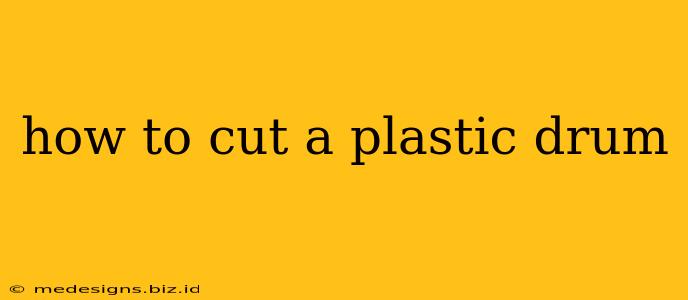Cutting a plastic drum might seem like a straightforward task, but it requires careful planning and the right tools to ensure safety and a clean cut. Improper techniques can lead to injury from sharp edges or hazardous fumes. This guide will walk you through the safest and most effective methods for cutting various types of plastic drums.
Assessing Your Plastic Drum
Before you begin cutting, it's crucial to identify the type of plastic drum you're working with. Different plastics require different cutting techniques. Common types include HDPE (high-density polyethylene) and polypropylene. Look for markings on the drum to identify the type of plastic. This information will help determine the best tools and methods for cutting. Additionally, always ensure the drum is completely empty and clean before attempting to cut it. Residual chemicals can be dangerous.
Essential Safety Precautions
Safety is paramount when cutting a plastic drum. Always wear appropriate personal protective equipment (PPE), including:
- Safety Glasses: Protect your eyes from flying debris.
- Gloves: Protect your hands from sharp edges and potential chemical residue.
- Dust Mask or Respirator: Some plastics release fumes when cut, especially if they've contained chemicals.
- Long Sleeves and Closed-Toe Shoes: Provide additional protection for your body.
Never cut a drum that contains flammable or hazardous materials. If unsure about the contents, seek professional help for disposal.
Tools and Techniques for Cutting Plastic Drums
Several methods can be used to cut plastic drums, each with its advantages and disadvantages:
1. Using a Rotary Cutter
A rotary cutter, often used in metalworking, is an effective option for HDPE and polypropylene drums. Ensure the blade is sharp and the cutter is powerful enough for the thickness of the drum. Use slow, steady movements to prevent the blade from overheating or binding.
- Advantages: Relatively fast and clean cut.
- Disadvantages: Requires a substantial amount of power and the right blade.
2. Using a Jigsaw
A jigsaw with a fine-tooth metal-cutting blade is suitable for plastic drums, especially if the cut needs to be precise or curved. Work slowly and use a steady hand to avoid vibrations that could lead to uneven cuts or breakage.
- Advantages: Versatile for intricate cuts.
- Disadvantages: Can be slower than a rotary cutter and requires more precision.
3. Using a Reciprocating Saw (Sawzall)
A reciprocating saw with a metal-cutting blade can cut through thicker plastic drums efficiently. However, exercise caution to prevent the saw from slipping and causing injury. Use a slow, controlled cutting speed.
- Advantages: Suitable for thick-walled drums.
- Disadvantages: Requires practice to avoid damage.
4. Using a Hand Saw
For thinner plastic drums, a hand saw with a fine-tooth blade can be used. This method requires more physical effort and time. Use a sawing motion that is even and slow to avoid cracking the plastic.
- Advantages: Does not require power tools.
- Disadvantages: Slow and requires more physical work.
Remember to always support the drum adequately to prevent it from shifting during the cutting process. A sturdy workbench or sawhorses are ideal.
Post-Cutting Considerations
After cutting the drum, carefully smooth any sharp edges with sandpaper or a file to prevent injuries. Consider how you will dispose of the cut pieces. Some recycling centers accept plastic drums; check with your local waste management facility.
Conclusion
Cutting a plastic drum safely and effectively requires the right tools, technique, and a strong emphasis on safety precautions. By following the guidelines in this comprehensive guide, you can successfully cut your plastic drum while minimizing the risk of injury. Remember to always prioritize safety first!
